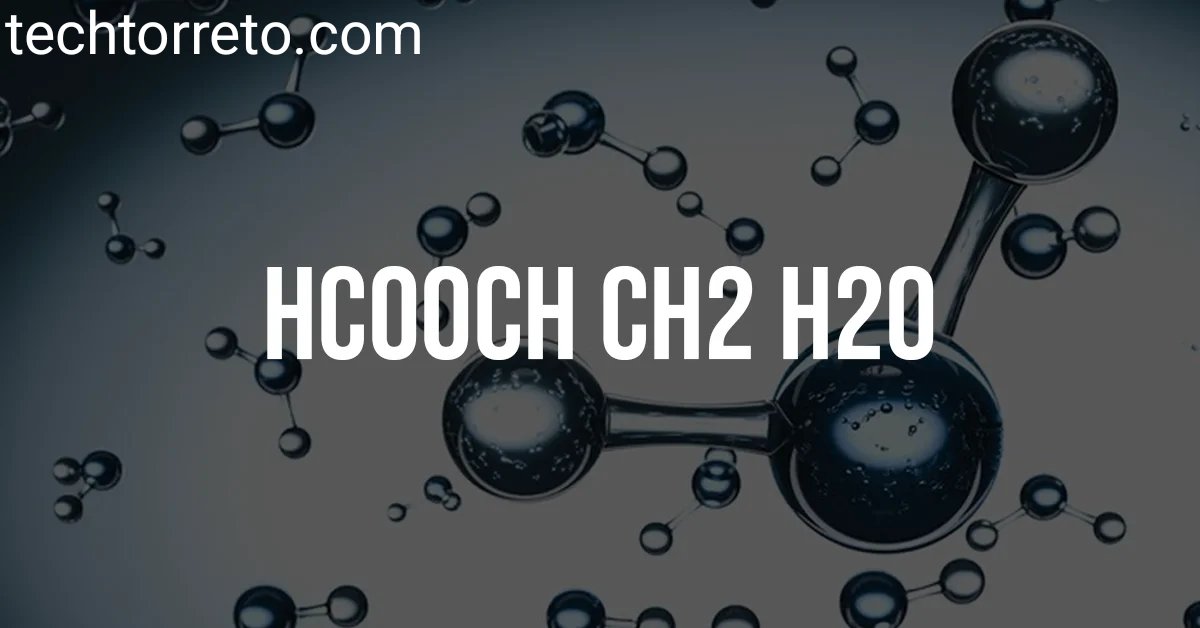HCOOCH CH2 H2O: Comprehensive Structure, Properties Reactions

Understanding chemical compounds is essential in both academic and industrial chemistry. One such combination that draws interest is HCOOCH CH2 H2O, a mix of chemical components that reveals insights into organic chemistry and hydrolysis reactions. In this article, we will dive into the compound’s components, structure, reactions, and applications while maintaining a strong focus on clarity and relevance.
What Is HCOOCH CH2 H2O?
HCOOCH refers to methyl formate, an ester derived from formic acid and methanol. When paired with CH2 (methylene group) and H2O (water), this chemical representation hints at a hydrolysis reaction or a component of a larger organic mechanism. Such compounds are often involved in intermediate reactions in synthetic organic chemistry.
Chemical Structure and Interpretation
To understand HCOOCH CH2 H2O, we must analyze it structurally:
- HCOOCH (Methyl Formate): H–C(=O)–O–CH3
- CH2 (Methylene): Represents a reactive group often found in polymerization or bridging reactions.
- H2O (Water): Often acts as a solvent or reactant in hydrolysis.
When combined, this formulation could represent a reaction scheme or a hydrolysis pathway involving methyl formate and methylene in an aqueous environment.
Properties of HCOOCH (Methyl Formate)
| Property | Value |
|---|---|
| Molecular Formula | C2H4O2 |
| Appearance | Colorless liquid |
| Boiling Point | 32°C |
| Solubility in Water | Miscible |
| Odor | Pleasant, fruity |
Methyl formate is volatile and flammable, making it a crucial compound in fragrance manufacturing and industrial solvents.
Role of Water (H2O) in the Reaction
Water plays a vital role in hydrolysis reactions. When methyl formate reacts with water, it undergoes acid- or base-catalyzed hydrolysis, breaking down into formic acid (HCOOH) and methanol (CH3OH):
HCOOCH3 + H2O → HCOOH + CH3OH
This reaction showcases the significance of water as a reactant in converting esters into alcohols and carboxylic acids.
Significance of CH2 Group
The methylene group (CH2) is a building block in many organic compounds. Although it doesn’t react independently in this representation, it often serves as a linking unit or intermediate in organic synthesis, particularly in polymer chains or alkylation reactions.
Reactions Involving HCOOCH CH2 H2O
1. Ester Hydrolysis
In acidic or basic environments, methyl formate reacts with water to produce methanol and formic acid.
2. Polymerization
In some synthetic routes, CH2 groups are involved in extending the carbon chain or initiating polymer backbones.
3. Decomposition Reactions
When exposed to heat or catalytic conditions, esters like methyl formate can decompose, especially in the presence of water and methylene intermediates.
Industrial Applications
The combined components in HCOOCH CH2 H2O point toward use in several industries:
- Perfume and Flavoring: Methyl formate is known for its fruity scent.
- Solvents: Used in manufacturing and degreasing applications.
- Synthetic Chemistry: Participates in esterification and hydrolysis reactions.
- Pharmaceuticals: Used in intermediate steps for active pharmaceutical ingredients.
Laboratory Considerations
Working with esters and water involves careful handling:
- Ventilation: Due to volatile fumes.
- Temperature Control: To avoid spontaneous reactions or evaporation.
- Proper Labeling: Chemical mixtures must be stored with clear identification.
Environmental Impact
While methyl formate breaks down quickly in the atmosphere, it still contributes to volatile organic compound (VOC) emissions. Responsible usage and disposal are essential in reducing environmental harm.
Frequently Asked Questions (FAQs)
1. What is HCOOCH?
HCOOCH refers to methyl formate, an ester formed from methanol and formic acid.
2. What happens when methyl formate reacts with water?
It undergoes hydrolysis to yield formic acid and methanol.
3. Is HCOOCH CH2 H2O a single compound?
No, it’s a combination of methyl formate, a methylene group, and water, likely indicating a reaction scheme.
4. What are the uses of methyl formate?
It is widely used as a solvent, in perfumes, and in organic synthesis.
5. Is this mixture safe to handle?
With proper lab safety, such as wearing gloves and working in a fume hood, it’s safe to handle.
6. Can this mixture be found in nature?
While individual components like water and methylene occur naturally, methyl formate is typically industrially synthesized.
Conclusion
Understanding HCOOCH CH2 H2O gives insight into the broader world of organic chemistry. It highlights the reactivity of esters, the importance of hydrolysis, and the roles water and methylene play in chemical transformations. Whether used in a laboratory or industrial context, mastering these interactions ensures better control over chemical reactions and end products.